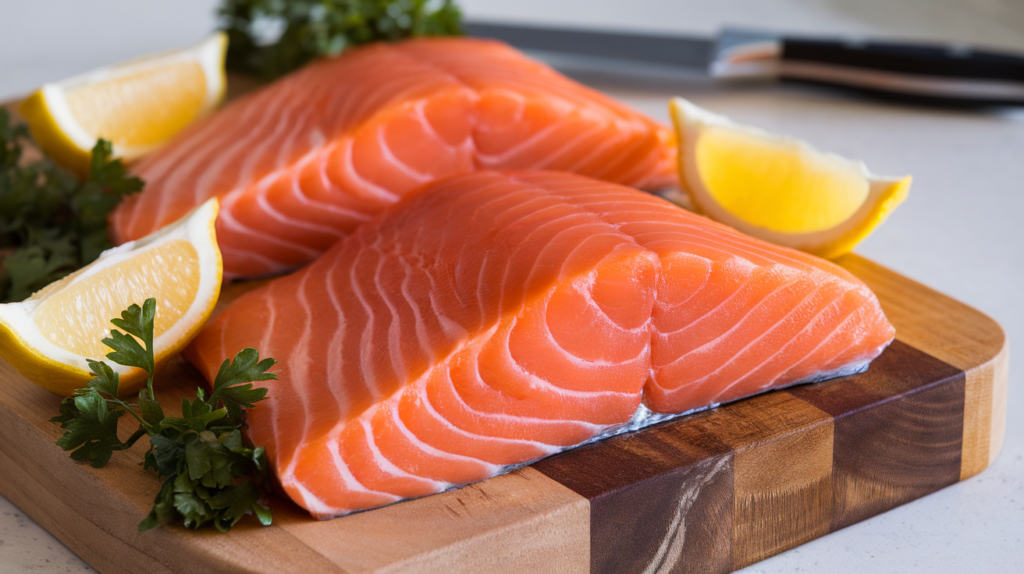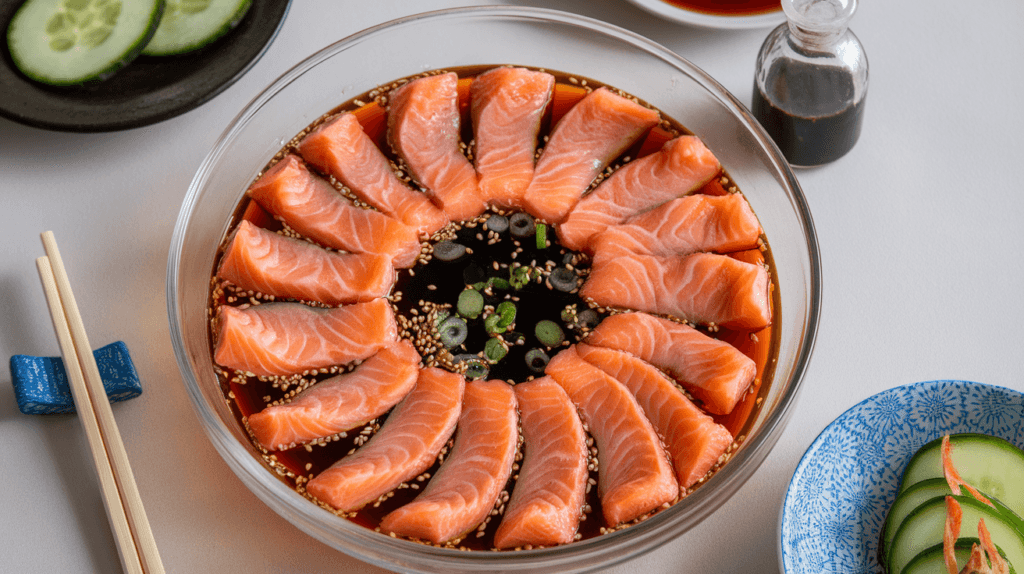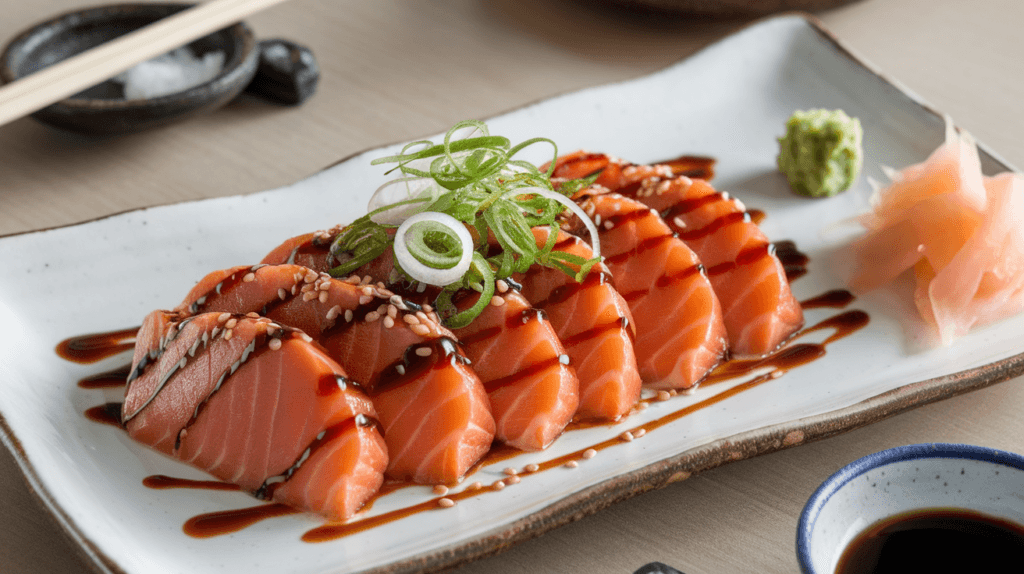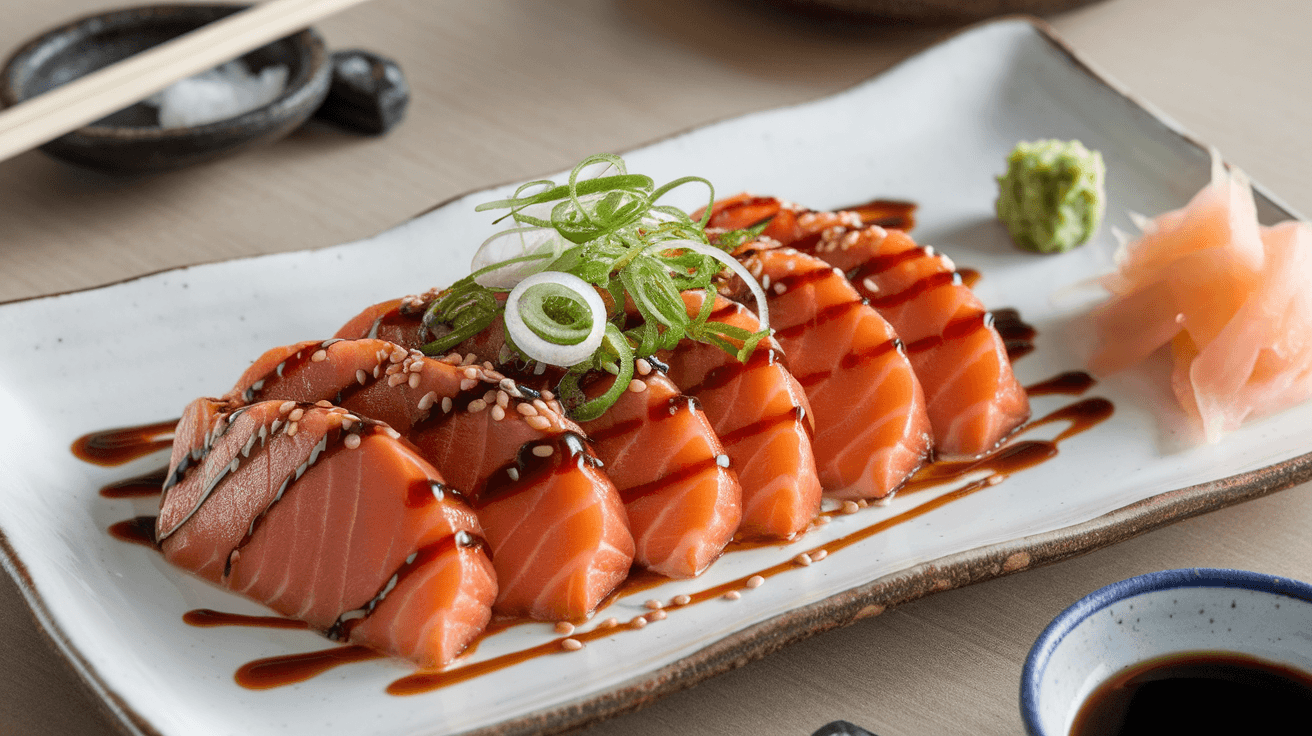Introduction
Raw salmon marinated in soy sauce is a popular dish in many cuisines, especially in Japanese and Hawaiian recipes like sashimi and poke bowls. But for many people, the question remains: Can I eat raw salmon marinated in soy sauce? This is a valid concern, as understanding the safety of raw fish is crucial.
Can I eat raw salmon marinated in soy sauce? The answer depends on various factors, including the quality of the salmon and how it’s prepared. In this article, we’ll delve into the safety, benefits, and risks of eating this dish. Additionally, we’ll share tips for preparation and alternatives to ensure a safe and enjoyable dining experience.
Why This Question Matters
The popularity of raw salmon dishes has surged in recent years, thanks to their delicious flavors and health benefits. However, eating raw fish poses potential risks, including foodborne illnesses. Understanding the facts behind eating raw salmon marinated in soy sauce is essential for ensuring both safety and enjoyment.
Overview of Marinating Salmon in Soy Sauce
Marinating salmon in soy sauce is not just about adding flavor—it’s a traditional method used in many cultures to enhance texture and taste. Soy sauce adds umami, while its saltiness can partially cure the fish. This process can elevate the dining experience, but does it impact safety? Let’s explore the details in the following sections.
The Basics of Eating Raw Salmon

Is Raw Salmon Safe to Eat?
Raw salmon can be safe to eat if handled and prepared correctly. It is commonly used in dishes like sashimi, sushi, and poke. However, not all salmon is suitable for raw consumption. Ensuring safety begins with choosing high-quality, sushi-grade salmon, which is processed to minimize the risk of parasites and bacteria.
The key factor lies in proper handling from harvest to table. This includes freezing the salmon at very low temperatures to kill any harmful parasites. Many countries have food safety regulations that require fish intended for raw consumption to be frozen for a specific duration before being sold.
Common Risks Associated with Eating Raw Salmon
While raw salmon is delicious, it comes with certain risks:
- Parasites: Raw fish may contain parasites like Anisakis, which can cause serious gastrointestinal issues if ingested.
- Bacterial Contamination: Bacteria like Salmonella and Listeria can grow if the fish is not stored and handled correctly.
- Cross-Contamination: Using unclean utensils or surfaces can transfer harmful bacteria to the fish.
These risks underscore the importance of sourcing your salmon from reputable vendors and following stringent food safety practices.
Health Benefits of Eating Salmon
Nutritional Benefits of Salmon
Salmon is packed with essential nutrients that make it a superfood. It is a rich source of:
- Omega-3 Fatty Acids: These healthy fats support brain function, heart health, and inflammation reduction.
- Protein: Salmon provides a complete protein profile, essential for muscle growth and repair.
- Vitamins and Minerals: It contains vitamins D, B12, and selenium, all vital for overall health.
When combined with soy sauce, the dish also incorporates additional benefits such as reduced sodium soy sauce options contributing to heart health.
Added Benefits of Soy Sauce in Marinades
Soy sauce is more than a flavor enhancer—it brings its own set of health benefits:
- Rich in Antioxidants: Soy sauce contains compounds that may reduce oxidative stress in the body.
- Flavor Profile: Its umami taste complements the fatty texture of salmon, making the dish more appealing.
However, moderation is key since traditional soy sauce is high in sodium. Opt for low-sodium versions to enjoy the flavor without overloading on salt.
Risks of Eating Raw Salmon Marinated in Soy Sauce
Parasites and Bacteria
Raw salmon poses potential risks, primarily from parasites and bacteria. Many wonder, “Can I eat raw salmon marinated in soy sauce?“ Although marinating in soy sauce can enhance flavor, it does not eliminate these risks. Parasites such as Anisakis and tapeworms are often found in raw fish, including salmon. If consumed, these parasites can cause symptoms like nausea, abdominal pain, and vomiting, raising concerns about the safety of eating raw salmon marinated in soy sauce.
Additionally, harmful bacteria like Salmonella and Listeria can survive in improperly handled or stored salmon. These bacteria can lead to foodborne illnesses, particularly for individuals with weakened immune systems.
Importance of Quality and Freshness
To minimize risks, it’s critical to select high-quality, fresh salmon. Here’s what to look for:
- Appearance: Fresh salmon should have a bright, vibrant color and no dull spots.
- Smell: It should smell clean, like the ocean, without any strong fishy odor.
- Texture: The flesh should be firm and spring back when pressed lightly.
Always purchase your salmon from a trusted source, and ask if it’s sushi-grade or previously frozen. Proper freezing helps kill parasites, ensuring a safer raw dining experience.
How to Choose Salmon for Raw Consumption
Wild-Caught vs. Farmed Salmon
One of the biggest debates in seafood is whether wild-caught or farmed salmon is better. For raw consumption, both options have pros and cons:
- Wild-Caught Salmon: It is typically leaner, with a more pronounced flavor. However, it may have a higher risk of parasites unless properly frozen.
- Farmed Salmon: Often raised in controlled environments, it may have fewer parasites but could contain higher levels of contaminants if not responsibly farmed.
Both types can be safe if they are sushi-grade and handled correctly. The choice depends on your personal preference and access to high-quality suppliers.
Sushi-Grade Salmon: What Does It Mean?
The term “sushi-grade” is not regulated in many countries but generally implies that the fish has been frozen to kill parasites. It’s essential to confirm with the seller that the salmon meets these standards. Sushi-grade fish is typically processed with extra care to ensure it is safe for raw consumption.
When in doubt, opt for sushi-grade salmon, and avoid fish that is simply labeled “fresh” without further details.
Proper Techniques for Marinating Salmon

Preparing Salmon for Marination
Before marinating salmon in soy sauce, proper preparation is key to ensuring both safety and flavor. Follow these steps:
- Inspect the Fish: Ensure the salmon is sushi-grade and has a fresh appearance and smell.
- Clean Utensils: Use sanitized knives, cutting boards, and containers to prevent cross-contamination.
- Slice Appropriately: Cut the salmon into thin, even slices to allow the marinade to penetrate effectively.
- Pat Dry: Remove excess moisture from the fish with a clean paper towel for better marinade absorption.
These steps not only enhance the taste but also minimize the risk of foodborne illnesses by maintaining cleanliness and proper handling.
Best Practices for Using Soy Sauce in Marinades
Soy sauce is a versatile ingredient, but its use in marinades requires some finesse. Here are some tips:
- Balance the Flavors: Combine soy sauce with complementary ingredients like ginger, garlic, sesame oil, or citrus juice for a more complex flavor profile.
- Marination Time: Limit marinating to 30 minutes to 1 hour. Prolonged exposure can overpower the salmon’s natural flavor and alter its texture.
- Use Low-Sodium Soy Sauce: This reduces sodium intake while still delivering the desired umami flavor.
For an authentic touch, try adding a hint of wasabi or rice vinegar to the marinade. These ingredients enhance the flavor without compromising the delicate taste of raw salmon.
Alternatives to Eating Raw Salmon

Lightly Cured or Seared Salmon
If you’re hesitant about eating fully raw salmon, lightly cured or seared options can be an excellent compromise. These methods offer a similar texture and flavor while reducing some of the risks associated with raw fish:
- Lightly Cured: Rub the salmon with a mixture of salt, sugar, and dill, then let it sit in the refrigerator for a few hours. This process partially “cooks” the salmon while preserving its raw texture.
- Seared: Briefly cook the edges of the salmon over high heat while keeping the center raw. This adds a caramelized flavor and creates a stunning presentation.
Vegan and Cooked Substitutes
For those who prefer to avoid raw fish altogether, there are plenty of substitutes:
- Cooked Salmon: Marinate and grill or bake the salmon for a fully cooked, flavorful dish.
- Vegan Substitutes: Use marinated tofu, jackfruit, or even carrots for a plant-based alternative that mimics the texture and taste of raw salmon.
These options allow you to enjoy the essence of a soy sauce-marinated dish without the potential risks of consuming raw fish.
Frequently Asked Questions
Can I Get Sick From Soy Sauce-Marinated Raw Salmon?
Yes, there is a possibility of getting sick from eating raw salmon marinated in soy sauce if the fish is not handled or sourced properly. Parasites and bacteria are the primary concerns. Marinating the salmon in soy sauce does not kill harmful pathogens; it only enhances flavor. To minimize risks, always use sushi-grade salmon and practice proper food safety measures.
How Long Can I Marinate Raw Salmon Safely?
Raw salmon should not be marinated for longer than 30 minutes to 1 hour. Prolonged marination can alter the fish’s texture, making it mushy, and increase the risk of bacterial growth if left at room temperature. Always marinate in the refrigerator to keep the fish fresh and safe to eat.
Can I Use Store-Bought Salmon for This Recipe?
Not all store-bought salmon is suitable for raw consumption. Most salmon available in supermarkets is intended to be cooked and may not meet the standards required for sushi-grade fish. If you plan to eat raw salmon, ensure that it is labeled as sushi-grade or ask your fishmonger for confirmation.
Does Soy Sauce “Cook” the Salmon?
No, soy sauce does not cook salmon in the way citrus juice does in ceviche. While the saltiness of soy sauce can slightly cure the fish, it does not eliminate harmful bacteria or parasites. This is why sourcing high-quality salmon is crucial if you plan to eat it raw.
What Are the Signs of Unsafe Salmon?
If your salmon has a strong fishy odor, a slimy texture, or appears discolored (especially with gray or brown spots), it is unsafe to eat raw. Fresh salmon should have a clean, ocean-like smell and firm, translucent flesh. When in doubt, discard the fish to avoid the risk of foodborne illness.
Are There Other Sauces Besides Soy Sauce for Marinating Raw Salmon?
Absolutely! You can experiment with various sauces to marinate raw salmon. Popular alternatives include ponzu sauce, miso-based marinades, or sesame-ginger dressing. Each sauce brings unique flavors while maintaining the essence of the dish. Just ensure the salmon is sushi-grade and follow safe preparation practices.
Conclusion
Eating raw salmon marinated in soy sauce can be a delightful culinary experience if done correctly. This dish is popular for its rich flavors and nutritional benefits, combining the healthy fats and protein of salmon with the umami taste of soy sauce. However, safety must always come first when preparing and consuming raw fish.
To enjoy this dish safely:
- Ensure you purchase high-quality, sushi-grade salmon from a trusted source.
- Follow proper food safety techniques, including freezing and handling the fish correctly.
- Limit marination time to avoid altering the texture of the fish.
For those who are hesitant about eating raw salmon, alternatives like lightly cured or seared salmon provide a similar taste with reduced risks. You can also explore vegan substitutes for a completely plant-based experience.
Ultimately, with the right precautions, raw salmon marinated in soy sauce can be a safe and enjoyable dish that brings together bold flavors and excellent nutrition. Always prioritize safety and quality, and don’t hesitate to experiment with flavors to create your own signature marinade.
So, can you eat raw salmon marinated in soy sauce? Yes, but only if you follow the necessary steps to ensure it is safe and fresh. Enjoy this delicacy responsibly, and savor the harmonious blend of flavors it offers!
Conclusion
Eating raw salmon marinated in soy sauce can be a delightful culinary experience when prepared safely and correctly. The combination of the salmon’s rich, buttery texture and the umami depth of soy sauce is truly irresistible. However, understanding the risks and following best practices is essential to ensure safety.
From choosing sushi-grade salmon to proper marination techniques, every step matters in creating a delicious and safe dish. If you’re not comfortable with raw salmon, alternatives like lightly cured or seared salmon can offer a similar experience without the associated risks.
Ultimately, whether you enjoy raw salmon marinated in soy sauce or prefer cooked or plant-based substitutes, the key is to prioritize quality, freshness, and proper handling. With this guide, you can confidently explore this dish and enjoy it as part of your culinary adventures.

